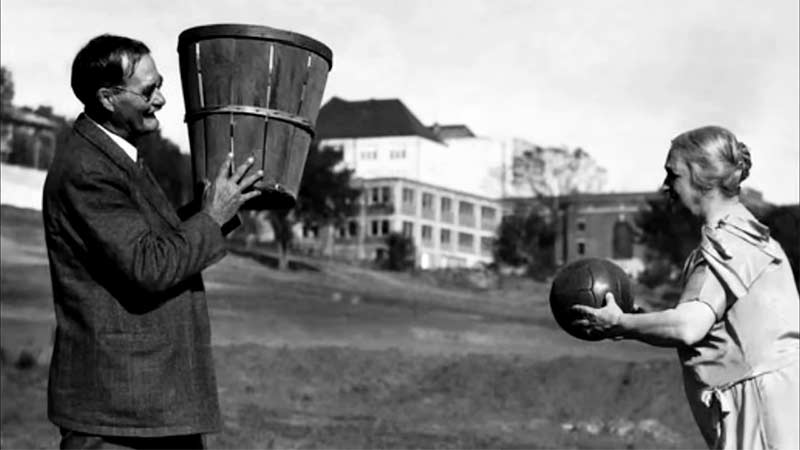Basketball, a game that has captivated millions, has a rich history stretching back to its invention in 1891 by James Naismith. Originally designed as a way to keep students active during the winter months, the sport quickly evolved from a simple indoor activity to a global phenomenon.
By the 1920s, the Amateur Athletic Union (AAU) Tournament had already become a significant event, showcasing the sport’s growing popularity.
Throughout the decades, basketball has seen remarkable transformations, from the playgrounds to professional leagues.
The game has not only produced legendary players but also reflected societal changes, including the rise of women’s basketball and the integration of various playing styles.
With its dynamic evolution, basketball remains an enduring and influential part of sports history, continually inspiring new generations of players and fans alike.
Origins of Basketball
Basketball, invented in 1891 by James Naismith to keep students active during winter, has evolved from a simple indoor activity into a global phenomenon, captivating millions around the world.
Invention by James Naismith
Basketball was invented by Dr. James Naismith, a 31-year-old Canadian physical education instructor.
In December 1891, while working at the International YMCA Training School in Springfield, Massachusetts, he sought to create a new game for students to stay active during winter. Luther Gulick, the physical education superintendent, tasked Naismith with this challenge.
Naismith’s solution was a game that required skill, could be played indoors, involved minimal physical contact, and used artificial light.
Initial Rules and Early Games
Naismith’s original 13 rules for basketball detailed ball movement, scoring, fouls, and other play fundamentals. Players couldn’t run with the ball and had to throw it from where they caught it.
Initially, the game featured 18 players, a soccer ball, and peach baskets nailed ten feet high as goals. The first public game occurred on January 20, 1892, at the YMCA in Albany, New York, with nine players per team and no dribbling.
Over time, rule modifications, including dribbling, quickened the game’s pace. YMCAs helped spread basketball, cementing its popularity in high schools and colleges nationwide for both men and women.
Evolution of the Sport
The evolution of basketball spans over decades, marked by significant changes in rules, playing styles, and the sport’s global reach.
Spread Among Colleges
Basketball quickly spread among colleges after its invention. The first known college basketball game took place in 1896 between the University of Iowa and the University of Chicago, featuring five players per side.
By the early 1900s, basketball had become entrenched in collegiate sports programs. College tournaments, such as the National Invitation Tournament (NIT) in 1938, helped boost the sport’s popularity.
The NIT was initially the most prestigious college basketball event until the NCAA Tournament gained prominence in the early 1950s.
Birth of Professional Leagues
Professional basketball began to take shape in the early 20th century. The Basketball Association of America (BAA) was founded in 1946, which later merged with the National Basketball League (NBL) to form the National Basketball Association (NBA) in 1949.
The NBA introduced a standardized set of rules and gained mainstream attention with standout performances from legendary players.
To complement the men’s league, the Women’s National Basketball Association (WNBA) launched in 1997, bringing notable athletes and elevating the sport’s profile.
Global Expansion and FIBA Formation
Basketball’s global expansion gained momentum in the mid-20th century. The formation of the International Basketball Federation (FIBA) in 1932 standardized rules for international competitions.
Through events like the Olympics and the FIBA World Cup, basketball reached audiences worldwide. Countries across Europe, Asia, and Africa embraced the sport, leading to a diverse talent pool and increased international competitive play.
The global expansion cemented basketball’s place as a mainstay in both professional and amateur sports arenas.
Milestones in Basketball History
Basketball’s journey is punctuated by significant milestones that have shaped the sport’s development and global impact.
Introduction of Key Rules
Basketball’s development has been shaped by key rule introductions. James Naismith’s 13 original rules in 1891 included no running with the ball and no physical contact. Over time, rules evolved to keep up with the game’s dynamics.
The 3-second rule (1936) aimed to reduce congestion near the basket, and the NBA’s 24-second shot clock (1954) increased the game’s pace. Free throws, rewarding one point for a successful shot from the 15-foot line, were introduced to penalize fouls.
Additional rules on rebounding and dribbling further refined offensive and defensive play.
Significant Games and Tournaments
Historically significant tournaments profoundly impacted basketball’s competitive landscape. The NIT in 1938 was the premier collegiate event until the NCAA Tournament, established in 1939, surpassed it by the early 1950s.
Television boosted these events’ popularity, with NCAA games gaining national broadcasts in 1963 and viewership growing explosively by the 1980s. Broadcast rights fees soared, reaching over $50 million by the late 1980s and $545 million per year by 2003.
The NBA, founded in 1946, and the WNBA, launched in 1997, created iconic sports moments and highlighted professional basketball. These developments show basketball’s evolution from a modest gym activity to a global spectacle.
Basketball Today
In the contemporary landscape, basketball stands as a global phenomenon, characterized by its widespread popularity, diverse talent pool, and technological advancements.
Modern Changes and Influences
Basketball today includes advancements in technology, training, and analytics that have transformed how the game is played and understood. The introduction of precision equipment, from shoes to wearable tech, has enhanced player performance and injury prevention.
Coaches now use software to analyze player stats, track performance metrics, and develop strategies.
Rule changes like the implementation of the designated shooter for technical fouls and the revision of the clear path foul illustrate how the sport evolves to keep pace with its dynamic nature.
Current Global Status
Currently, basketball is a global sport, played and followed by millions. The NBA remains the flagship professional league, attracting international talents and broadcasting games worldwide.
Other leagues, such as the EuroLeague in Europe and the CBA in China, have significant followings and contribute to the sport’s growth.
Events like the FIBA Basketball World Cup and the Summer Olympics further elevate basketball’s international prominence, bringing together top talents from diverse countries to compete on the world stage.
Frequently Asked Questions
When and where was the first public game of basketball played?
The first public basketball game was played on March 11, 1892, at the International YMCA Training School in Springfield, Massachusetts.
What is the significance of the 24-second shot clock in basketball?
Introduced in 1954, the 24-second shot clock increased the pace of the game by limiting the amount of time a team could possess the ball before attempting a shot.
How has technology impacted modern basketball?
Technology has revolutionized basketball through advanced analytics, enhanced training methods, instant replay, and player tracking systems, all contributing to improved performance and fan engagement.
What role do international tournaments play in basketball?
International tournaments like the FIBA Basketball World Cup and the Olympics provide a global platform for the best players from around the world to compete, promoting the sport internationally.
Which leagues are significant for basketball’s global growth besides the NBA?
Besides the NBA, leagues such as the EuroLeague and the Chinese Basketball Association (CBA) play crucial roles in expanding basketball’s global reach and popularity.
Conclusion
Basketball’s journey from a simple game invented by Dr. James Naismith to a global phenomenon is a testament to its universal appeal and adaptability.
Over the decades the sport has embraced changes in rules and technology while fostering a community that spans continents. The NBA stands as a beacon of excellence attracting talent from around the world and inspiring millions.
Other leagues and international tournaments further contribute to basketball’s rich and diverse tapestry. As the sport continues to evolve its future looks promising with endless possibilities for growth and innovation.
Basketball’s grassroots initiatives are also vital, nurturing young talent and promoting physical fitness globally. With digital platforms enabling real-time engagement, the sport’s reach is broader than ever, ensuring its place in the hearts of future generations.








Buzz Williams